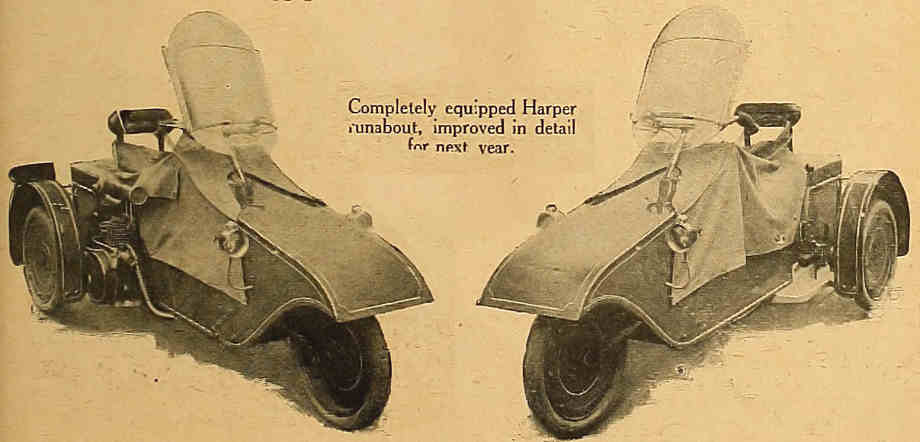



(All main features covered by Patents)
Backed by 20 years' engineering experience.
Not a camouflaged motor cycle, and nothing like a scooter!
The Harper Runabout motorised tricycle was manufactured by A.V. Roe and Co Ltd at their aircraft factory in Manchester from 1921 to 1926. Designed by R. O. Harper, the machine had a plywood body mounted on a steel frame with cast-iron fittings and was powered by a single cylinder 269cc Villiers engine with a 3-speed gearbox. It was capable of 40 mph and gave 100 miles per gallon.
Seating was unusual in that it was back to back, the passenger facing rearwards. All three wheels had leaf-spring suspension, were detachable, and had what are described as "disc-type" brakes.
Controls, apart from the steering which is by motorcycle handlebars, is automotive fashion - throttle, clutch and brakes are by foot pedal.
Some 500 of these curious but eminently sensible vehicles were built.
Founded in 1910, the Avro company became part of the Hawker Siddeley group in 1935. See also Hawker
Manchester's Museum of Science and Industry has a Harper Runabout in its collection.
NOVEMBER 30th, 1922. Page 871
The Olympia Show.

HARPER RUNABOUT. (122.)
Solo Three-wheelers. 2 H.P. Model.
E. H. Carlisle and Co., Ltd., 188, Deansgate, Manchester.
The Harper runabout stands in a class by itself. Its designers, recognising the demand for an exceptionally light, handy vehicle giving complete weather protection, have succeeded in producing a most, attractive little three-wheeler. Low upkeep and running costs are claimed for it, and, considering the power unit is only of 269 c.c. capacity and the entire weight only 280 lb., the claim may well be justified. A three-speed gear, chain transmission giving direct drive on all speeds, Zenith carburetter, independent foot and hand brakes, starting from the seat by lever, and foot acceleration are details which go to the making of a workmanlike little runabout.
The matter of luggage-carrying has been well considered, the space under the emergency extra seat being ample for light parcels, while provision has been made for the carrying of such things as golf clubs, fishing rods, and tennis rackets. The whole of the mechanism and body is supported on the quarter-elliptic springs, a desirable feature for so small a machine. On the question of actual road performance the little Harper can boast of a good record in the Scottish Six Days Trials. For the makers to have entered such an arduous event with a three-wheeler fitted with so small an engine exemplified fully their faith in the machine, and their temerity was justified.
Tradesman's box carrier models are available.
Olympia Show 1922
N.B. R. H. Carlisle and Co of Manchester was a dealer.

A plucky pair who have started the formidable trial on Harper runabouts, fitted with 269 c.c. engines. Armstrong Graham and R. O. Harper.
Will be Watched Closely.
The Harper runabouts turned up in good time, and caused considerable speculation among the onlookers as to the procedure on Amulree — would the riders remain tied up in their storm aprons and, if so, what was going to happen if they failed? The drivers themselves, however, appeared confident that the difficulty would not arise. Two spare wheels and tyres were carried on each, the wheels, of course, being detachable and interchangeable. To use a well-worn phrase, their performances will be watched with interest.
The Motor Cycle reports on the Scottish Six Days Trials, May 4th 1922, page 585.
Sources: Graces Guide, The Motor Cycle, yesterdays.nl
If you have further information or a query related to this page, please contact us